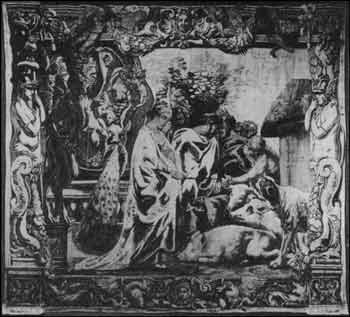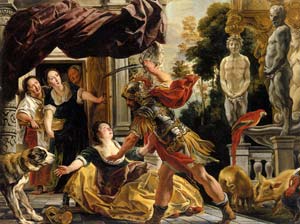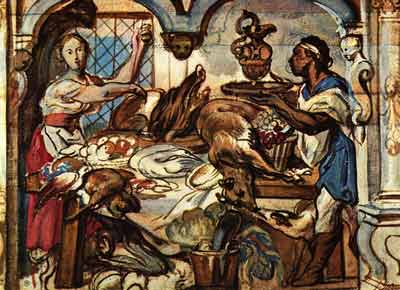Flemish, (1593-1678)

-
Kirke zmieniająca towarzyszy Odyseusza w świnie
- (Circe transforming Odysseus’s men into swine)
- (c. 1630-1632), wool and silk tapestry
- Private collection
-
Editor’s Note:
Jordaens collaborated with several Brussels workshops over the course of his career creating tapestry designs. This work above has been identified as Jordaens’ design. It is also marked “B. B.”, the mark of the city of Brussels, but an additional mark, “R.A.V.P.” cannot be identified with any known tapestry weavers.
This is possibly part of a ten tapestries set representing the story of Odysseus. On October 5, 1624 Gaspard Nagodt, treasurer of the Prince of Poland, Władysław Vasa, signed a contract with a Brussels’ weaver Jacob Geubels the Younger for delivery such a set.
Each tapestry was described as of six yards in height with the complete set comprising 594 yards and costing 19,008 florins. Probably due to the Prince’s financial difficulties, the tapestries were not executed until Geubels’ death in 1629, and the commission was accomplished by an unknown workshop.
In the letter from September 15, 1632, Prince Władysław Vasa asked Christian IV, King of Denmark, to release his tapestries from customs.
About the Artist
Jacob Jordaens, (1593-1678) was a Flemish painter. He painted altarpieces, mythological, and allegorical scenes, genre scenes based on proverbs and also banquet scenes. He was also prominent designer of tapestries.
Jordaens was one of the three Flemish Baroque painters, along with Peter Paul Rubens and Anthony van Dyck, to bring prestige to the Antwerp school of painting. Jordaens worked for Rubens, along with van Dyck, until van Dyck left for Italy, then Jordaens became Rubens’ principal associate until the latter’s death in 1640. He also ran his own own large and successful workshop while working for Rubens and continued after Rubens’ death. [DES-01/11]


